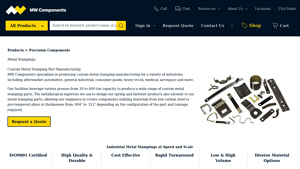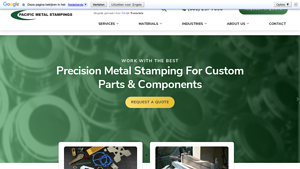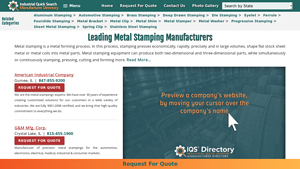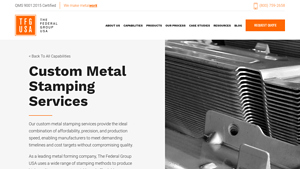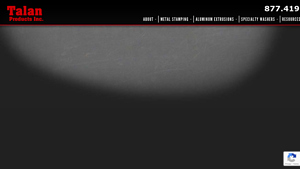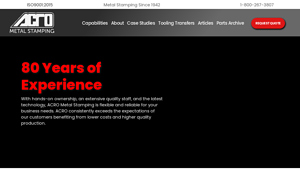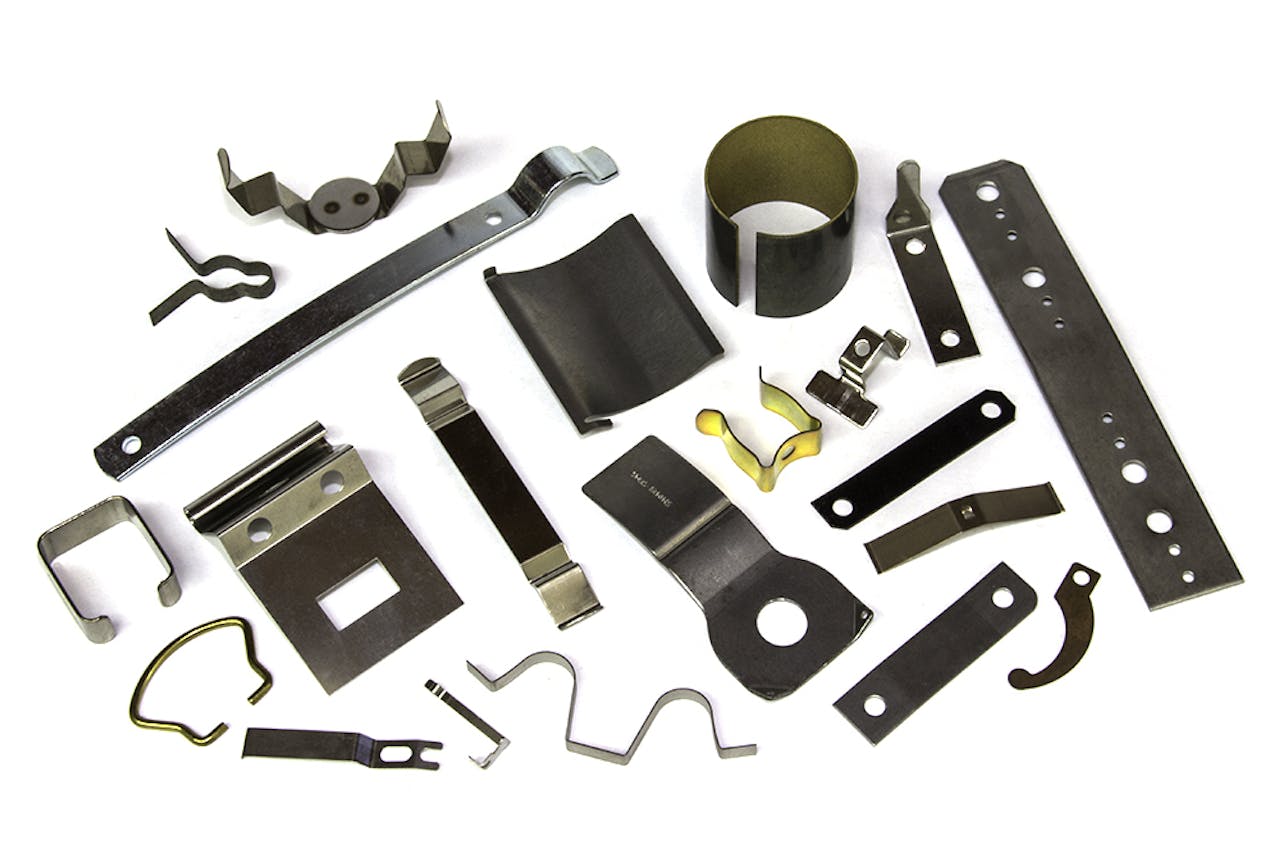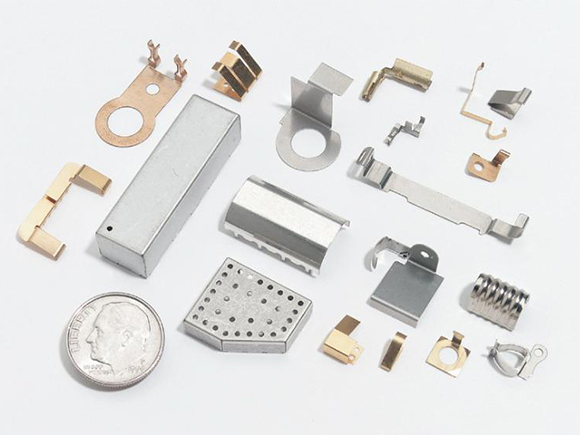Top 6 Metal Stamping Parts Manufacturer List and Guide
Top 6 Metal Stamping Parts Manufacturer Manufacturers & Suppliers List
1. MW Components – Metal Stampings & Precision Parts
Domain: mwcomponents.com
Registered: 2017 (8 years)
Introduction: Metal Stampings & Parts, Metal Stamping Manufacturing, Custom Metal Tubing, Parts Assemblies, Snap Rings & Retaining Rings, Electroforms, Mandrels and Cutting Arbors, Precision Components, Custom Machined Parts, Metal Flanges, Electrical Contacts.
2. Pacific Metal Stampings – Precision Metal Stamped Parts
Domain: pacificmetalstampings.com
Registered: 1999 (26 years)
Introduction: Pacific Metal Stampings is a leading manufacturer of precision metal stamped parts, offering custom component parts from a variety of materials including Aluminum, Brass, Beryllium Copper, Chromoly 4130 Steel, Copper, Cold Rolled Steel, Galvanized Steel, Hastelloy, Haynes Stainless Steel, Inconel 718, Phosphor Bronze, Spring Steel 1095, Stainless Steel (301, 304, 316/316L, 321 & 347, 17-7PH), Tita…
3. Metal Stamper – Key Metal Stamping Products
Domain: metalstamper.net
Registered: 2001 (24 years)
Introduction: Metal stamping is a metal forming process that shapes flat stock sheet metal or metal coils into parts using stamping presses. Key products include: Aluminum Stamping, Automotive Stamping, Brass Stamping, Deep Drawn Stamping, Die Stamping, Eyelet, Ferrule, Fourslide Stamping, Metal Bracket, Metal Clip, Metal Shim, Metal Washer, Progressive Stamping, Sheet Metal Stamping, Spring Clip, and Stainless…
4. TFG USA – Custom Metal Stamping Solutions
Domain: tfgusa.com
Registered: 2008 (17 years)
Introduction: Custom metal stamping services providing affordability, precision, and production speed. 45+ years of industry expertise, tailored engineering solutions, and cutting-edge technology. Industries served include consumer products, agriculture, and healthcare. Techniques used: blanking, punching, coining, bending, flanging, drawing/forming, embossing, curling, and piercing. Equipment includes multiple…
5. Talan Products – High-Volume Metal Stamping & Aluminum Extrusions
Domain: talanproducts.com
Registered: 1998 (27 years)
Introduction: Talan Products specializes in high-volume metal stamping, aluminum extrusions, and specialty washers. They utilize high-speed presses and progressive dies, adhering to ISO 9001-2015 quality standards. Their metal stamping services include precision stamping and fabricated aluminum extrusion manufacturing for OEM customers. Talan offers Just-In-Time (JIT) extrusions that can be cut-to-length, pierc…
6. Acro Metal Stamping – Precision Metal Stampings
Domain: acrometalstamping.com
Registered: 1997 (28 years)
Introduction: Acro Metal Stamping specializes in precision metal stampings, including custom engineered tight tolerance components such as extrusion inserts, gaskets, electrical connectors, terminals, shims, bearings, washers, drawn cups, and discs. They utilize progressive and compound dies produced in their in-house toolroom, which allows for cost reduction, improved quality, and faster turnaround times. Acro…
Introduction: Navigating the Global Market for metal stamping parts manufacturer
In today’s competitive landscape, sourcing high-quality metal stamping parts manufacturers can be a daunting challenge for international B2B buyers. With a diverse array of suppliers across continents, particularly in regions like Africa, South America, the Middle East, and Europe, companies must navigate a complex marketplace to find reliable partners. This comprehensive guide serves as a vital resource, addressing critical aspects such as types of metal stamping processes, applications across various industries, and essential supplier vetting criteria.
From understanding the nuances of precision stamping to evaluating cost structures and lead times, this guide equips buyers with the insights necessary to make informed purchasing decisions. As the demand for custom components continues to grow in sectors like automotive, aerospace, and electronics, it is crucial for businesses to identify manufacturers that not only meet quality standards but also align with their operational needs.
By leveraging this guide, B2B buyers can streamline their sourcing process, reduce risks associated with supplier selection, and ultimately enhance their supply chain efficiency. Whether you are a manufacturer seeking to expand your supplier network or a procurement professional aiming to optimize costs, this resource will empower you to confidently navigate the global market for metal stamping parts, ensuring you secure the best possible partnerships for your business.
Understanding metal stamping parts manufacturer Types and Variations
| Type Name | Key Distinguishing Features | Primary B2B Applications | Brief Pros & Cons for Buyers |
|---|---|---|---|
| Progressive Die Stamping | Utilizes a single die to perform multiple operations | Automotive parts, electronic components | Pros: High efficiency; suitable for large volumes. Cons: Higher initial tooling costs. |
| Deep Draw Stamping | Forms metal into hollow shapes through deep drawing | Kitchenware, automotive parts | Pros: Excellent for complex shapes; high precision. Cons: Limited material thickness options. |
| Transfer Stamping | Transfers metal from one station to another for processing | Aerospace components, heavy machinery | Pros: Versatile; can handle large parts. Cons: More complex setup; longer lead times. |
| Blanking and Piercing | Cuts out shapes from metal sheets or coils | Appliance parts, brackets | Pros: Cost-effective for simple shapes; quick turnaround. Cons: Limited to flat shapes. |
| CNC Metal Stamping | Combines CNC machining with stamping processes | Custom parts for various industries | Pros: Highly customizable; precise tolerances. Cons: Slower production rates compared to traditional stamping. |
What are the Key Characteristics of Progressive Die Stamping?
Progressive die stamping is characterized by its ability to perform multiple operations in a single pass through a series of dies. This method is particularly effective for high-volume production runs, making it ideal for industries such as automotive and electronics. When considering progressive die stamping, B2B buyers should evaluate initial tooling costs against long-term production efficiency, as this method can significantly reduce per-unit costs over large orders.
How Does Deep Draw Stamping Support Complex Shapes?
Deep draw stamping excels at forming metal into complex, hollow shapes through a deep drawing process. This technique is commonly used in manufacturing kitchenware and automotive components, where precision and form are critical. Buyers should consider the suitability of materials and thickness, as deep draw stamping may not accommodate thicker metals, potentially limiting applications.
What Makes Transfer Stamping Unique?
Transfer stamping involves moving metal parts between different stations for various processing steps, allowing for intricate designs and larger components. This method is widely used in the aerospace and heavy machinery sectors. B2B buyers should weigh the versatility of transfer stamping against its complexity and longer setup times, which may impact project timelines.
What are the Advantages of Blanking and Piercing?
Blanking and piercing are fundamental stamping processes that cut shapes from flat sheets of metal. This method is cost-effective and quick, making it suitable for producing simple shapes like appliance parts and brackets. Buyers should note that while this process is efficient, it is limited to flat shapes and may not be suitable for more complex designs.
How Does CNC Metal Stamping Enhance Customization?
CNC metal stamping integrates computer numerical control with traditional stamping methods, offering high levels of customization and precision. This process is beneficial for producing custom parts across various industries, as it allows for tight tolerances and intricate designs. However, buyers should consider the slower production rates compared to conventional stamping methods, which may affect lead times for larger orders.
Key Industrial Applications of metal stamping parts manufacturer
| Industry/Sector | Specific Application of metal stamping parts manufacturer | Value/Benefit for the Business | Key Sourcing Considerations for this Application |
|---|---|---|---|
| Automotive | Production of body panels and brackets | Supports high-volume production with precise specifications | Consider lead times, material certifications, and tooling costs |
| Aerospace | Manufacturing of lightweight structural components | Enhances efficiency and safety in aircraft design | Evaluate compliance with aviation standards and material traceability |
| Electronics | Creation of connectors and device contacts | Ensures reliable electrical performance in devices | Focus on quality control processes and RoHS compliance |
| Medical Devices | Fabrication of surgical instruments and components | Meets stringent regulatory standards for safety and reliability | Assess certifications, prototyping capabilities, and delivery timelines |
| Consumer Goods | Production of durable components for appliances | Increases product lifespan and functionality | Analyze cost-effectiveness and customization options |
How is Metal Stamping Used in the Automotive Industry?
In the automotive sector, metal stamping is crucial for the production of body panels, brackets, and various engine components. These parts must meet stringent quality standards while being produced in large quantities to keep up with demand. For international buyers, especially from regions like Africa and South America, it is essential to source manufacturers who can provide precise specifications, quick turnaround times, and cost-effective tooling solutions. Ensuring that suppliers are ISO certified can also help mitigate risks associated with quality and compliance.
What Role Does Metal Stamping Play in Aerospace Manufacturing?
Aerospace manufacturers rely on metal stamping to create lightweight yet robust components such as brackets, frames, and fasteners. These parts must adhere to strict safety and performance standards due to their critical role in aircraft functionality. Buyers from the Middle East and Europe should prioritize manufacturers that can demonstrate compliance with aviation regulations and provide traceability for materials used. Additionally, understanding the supplier’s capacity for innovation and customization is vital for meeting unique design requirements.
How is Metal Stamping Essential in the Electronics Sector?
In the electronics industry, metal stamping is utilized to produce connectors, terminals, and contacts that are fundamental for device functionality. The precision of these components directly impacts the reliability and performance of electronic devices. For B2B buyers, particularly in regions like Vietnam, sourcing from manufacturers with robust quality control processes and compliance with RoHS standards is crucial. This ensures that the components are not only high-quality but also environmentally compliant, which is increasingly important in global markets.
Why is Metal Stamping Important for Medical Device Manufacturing?
Metal stamping is integral to the fabrication of surgical instruments and medical components, where precision and safety are paramount. Manufacturers must comply with rigorous regulatory standards, making it essential for buyers to work with suppliers who have the necessary certifications and quality assurance processes in place. International buyers, especially from regions with stringent medical regulations, should assess a manufacturer’s ability to provide prototypes and adhere to tight delivery schedules, ensuring that their production timelines are met without compromising on quality.
How Does Metal Stamping Benefit the Consumer Goods Sector?
In consumer goods, metal stamping is employed to create durable components for appliances, furniture, and other products. The durability and functionality of these parts enhance the overall quality of the final products, making them more appealing to consumers. Buyers from various regions should focus on the cost-effectiveness of sourcing stamped components while also considering customization options to meet specific design requirements. Ensuring that suppliers can deliver high-quality parts consistently will contribute to the long-term success of consumer goods manufacturers.
3 Common User Pain Points for ‘metal stamping parts manufacturer’ & Their Solutions
Scenario 1: Navigating Quality Assurance in Metal Stamping Parts
The Problem: International B2B buyers often face challenges regarding the quality and consistency of metal stamping parts. Variability in quality can arise from differences in manufacturing processes, materials, and compliance with international standards. This inconsistency can lead to production delays, increased costs, and compromised product integrity, which is especially critical in industries like automotive and aerospace where precision is paramount.
The Solution: To mitigate quality concerns, buyers should prioritize sourcing manufacturers that adhere to recognized international standards such as ISO 9001. Conducting thorough due diligence is essential; this includes reviewing certifications, quality control processes, and past client testimonials. Establishing a clear communication channel with the manufacturer can also facilitate real-time quality assurance checks. It’s beneficial to request sample parts before placing a large order, allowing buyers to evaluate the quality firsthand. Additionally, consider engaging third-party quality assurance services to conduct audits or inspections at the manufacturer’s facility. This proactive approach ensures that the parts meet the required specifications and reduces the risk of costly production issues down the line.
Scenario 2: Overcoming Communication Barriers with International Suppliers
The Problem: B2B buyers often encounter significant communication barriers when dealing with international metal stamping manufacturers. Differences in language, time zones, and cultural practices can lead to misunderstandings regarding project specifications, timelines, and pricing structures. Such miscommunications can result in delays and increased costs, ultimately affecting the buyer’s ability to meet their own production deadlines.
The Solution: To enhance communication with international suppliers, buyers should invest in establishing a clear and structured communication plan. This could include defining preferred communication channels (e.g., email, video calls) and scheduling regular check-ins to discuss project progress. Utilizing translation services or hiring bilingual staff can bridge language gaps, ensuring that both parties fully understand specifications and expectations. It’s also helpful to create detailed documentation of all agreements and specifications, which can serve as a reference point for both sides. Additionally, leveraging project management tools can keep all stakeholders aligned on timelines and deliverables, reducing the likelihood of misunderstandings and ensuring smoother collaboration throughout the project lifecycle.
Scenario 3: Managing Lead Times and Delivery Schedules
The Problem: In the fast-paced world of manufacturing, lead times and delivery schedules can be a significant pain point for B2B buyers. Unpredictable delays from metal stamping manufacturers can jeopardize production schedules and lead to missed deadlines. This issue is exacerbated when dealing with suppliers from different regions, where shipping logistics and customs processes may introduce additional delays.
The Solution: To effectively manage lead times, buyers should establish a robust planning process that includes buffer times in their production schedules. When sourcing metal stamping parts, it’s crucial to inquire about the manufacturer’s typical lead times and their capacity to handle urgent requests. Building strong relationships with suppliers can also facilitate better prioritization of orders. Implementing a just-in-time inventory system can help manage stock levels and reduce dependency on suppliers for immediate delivery. Additionally, consider diversifying your supplier base by establishing relationships with multiple manufacturers across different regions. This strategy not only provides alternatives in case of delays but also allows for a more flexible and responsive supply chain, ultimately ensuring that production schedules remain on track.
Strategic Material Selection Guide for metal stamping parts manufacturer
What Are the Key Properties of Common Materials Used in Metal Stamping?
Metal stamping manufacturers often utilize a variety of materials, each with distinct properties that influence performance, cost, and application suitability. Understanding these materials is crucial for international B2B buyers looking to optimize their procurement strategies.
How Does Aluminum Perform in Metal Stamping Applications?
Aluminum is a lightweight metal known for its excellent corrosion resistance and good thermal conductivity. It typically has a temperature rating up to 200°C and can withstand moderate pressure. The primary advantages of aluminum include its low weight, which is beneficial in automotive and aerospace applications, and its recyclability, making it an environmentally friendly option. However, aluminum can be more expensive than other materials, and its lower strength compared to steel may limit its use in high-stress applications. For international buyers, compliance with standards such as ASTM B209 is essential, particularly in regions like Europe and North America, where quality assurance is paramount.
What Are the Benefits and Limitations of Stainless Steel in Metal Stamping?
Stainless steel is renowned for its exceptional strength, durability, and corrosion resistance, making it a preferred choice in industries such as medical, automotive, and aerospace. It can handle high temperatures (up to 800°C) and pressures, ensuring reliability in demanding environments. The main advantages include its long lifespan and low maintenance requirements. However, stainless steel can be more challenging to work with due to its hardness, which may increase manufacturing complexity and costs. International buyers should be aware of the various grades (e.g., 304, 316) and relevant standards like ASTM A240 to ensure compliance with local regulations.
Why Choose Brass for Metal Stamping Parts?
Brass is an alloy of copper and zinc, known for its excellent machinability and corrosion resistance. It is often used in electrical applications due to its good conductivity. Brass can withstand moderate temperatures and pressures, making it suitable for various applications, including plumbing fittings and decorative components. The key advantages of brass include its aesthetic appeal and ease of fabrication. However, it is generally more expensive than steel and can be less durable in high-stress environments. Buyers from regions like South America and Africa should consider local availability and pricing fluctuations when selecting brass components.
What Role Does Cold Rolled Steel Play in Metal Stamping?
Cold rolled steel is a popular choice for metal stamping due to its high strength and excellent surface finish. It is suitable for applications requiring high precision, such as automotive parts and industrial machinery. Cold rolled steel can withstand high pressures and is often treated for enhanced corrosion resistance. The primary advantages include cost-effectiveness and versatility. However, it may require additional surface treatments to improve corrosion resistance, which can add to manufacturing complexity. International buyers should ensure that the steel meets standards such as ASTM A1008 to guarantee quality and compliance.
Summary Table of Material Properties for Metal Stamping
| Material | Typical Use Case for metal stamping parts manufacturer | Key Advantage | Key Disadvantage/Limitation | Relative Cost (Low/Med/High) |
|---|---|---|---|---|
| Aluminum | Automotive and aerospace components | Lightweight and corrosion-resistant | Higher cost and lower strength | Medium |
| Stainless Steel | Medical devices and automotive parts | High strength and durability | Manufacturing complexity and cost | High |
| Brass | Electrical connectors and plumbing fittings | Excellent machinability and aesthetics | Higher cost and less durability | Medium |
| Cold Rolled Steel | Industrial machinery and precision parts | Cost-effective and versatile | Requires surface treatment | Low |
This guide provides a comprehensive overview of material selection for metal stamping, aiding international B2B buyers in making informed decisions tailored to their specific needs and regional standards.
In-depth Look: Manufacturing Processes and Quality Assurance for metal stamping parts manufacturer
What Are the Key Stages in the Manufacturing Process of Metal Stamping Parts?
The manufacturing process of metal stamping parts is a critical component for B2B buyers seeking reliable and high-quality components. The process typically consists of several key stages: material preparation, forming, assembly, and finishing.
Material Preparation
The first step in the metal stamping process involves selecting the appropriate material based on the specific requirements of the final product. Common materials include aluminum, brass, stainless steel, and specialty alloys such as beryllium copper and Inconel. Material thickness, hardness, and surface finish are considered during this stage. Once selected, the material is cut into manageable sheets or coils, which are then inspected for quality and consistency before moving to the next stage.
Forming
Forming is where the actual stamping takes place. This process can include techniques such as blanking, bending, coining, and piercing. Stamping presses apply significant force to shape the material into the desired form, producing both two-dimensional and three-dimensional components. Advanced equipment, such as CNC machines and hydraulic presses, are often used to ensure precision and efficiency. The choice of technique depends on the complexity of the part and the volume required, ranging from small batches to mass production.
Assembly
Following forming, parts may require assembly. This stage can involve combining multiple stamped components or integrating additional elements, such as fasteners or electronic components. This is particularly relevant for industries such as automotive and electronics, where complex assemblies are common. Automated assembly lines may be employed to enhance efficiency and reduce labor costs.
Finishing
The finishing stage enhances the appearance and functionality of the stamped parts. Techniques such as deburring, polishing, and surface coating (e.g., plating, anodizing, or painting) are commonly used to meet aesthetic and performance standards. This stage is vital for ensuring that parts are ready for their intended application and can withstand environmental factors such as corrosion and wear.
How Is Quality Assurance Implemented in Metal Stamping?
Quality assurance (QA) is a critical aspect of the metal stamping manufacturing process, ensuring that products meet both international standards and customer specifications.
International Standards and Compliance
Most reputable metal stamping manufacturers adhere to international quality management standards such as ISO 9001. This certification demonstrates a commitment to quality and continuous improvement. Depending on the industry, additional certifications may be required. For instance, CE marking is essential for products sold in the European market, while API certification is vital for components in the oil and gas sector.
Quality Control Checkpoints
Quality control is integrated into various stages of the manufacturing process, typically divided into three main checkpoints:
-
Incoming Quality Control (IQC): At this initial stage, raw materials are inspected to ensure they meet specified standards. This includes checking for material properties and dimensions before they enter production.
-
In-Process Quality Control (IPQC): During manufacturing, regular inspections are performed to monitor the stamping process. This includes verifying that machinery is operating correctly and that parts are being produced to specifications.
-
Final Quality Control (FQC): After production, the finished products undergo a final inspection. This includes dimensional checks, visual inspections, and functional tests to confirm that they meet the required standards.
What Testing Methods Are Commonly Used in Quality Assurance for Metal Stamping?
To ensure the integrity and reliability of stamped components, various testing methods are employed throughout the manufacturing process. Common testing techniques include:
-
Dimensional Inspection: Using tools such as calipers, micrometers, and coordinate measuring machines (CMM), manufacturers verify that parts meet specified dimensions.
-
Material Testing: Tests such as tensile strength, hardness, and metallographic analysis assess the material properties to ensure they meet required specifications.
-
Functional Testing: For assemblies, functional tests simulate operational conditions to confirm that components perform as intended.
-
Visual Inspection: This involves checking for surface defects, such as scratches, dents, or improper finishes that could affect the part’s performance.
How Can B2B Buyers Verify Supplier Quality Control Processes?
For international B2B buyers, verifying a supplier’s quality control processes is essential to ensure they receive high-quality parts. Here are actionable steps to consider:
-
Audits: Conduct regular supplier audits to assess their manufacturing processes, equipment, and quality control measures. This may include reviewing their ISO certifications and compliance with industry standards.
-
Quality Reports: Request detailed quality reports that outline the supplier’s inspection processes, testing results, and any corrective actions taken in response to defects.
-
Third-Party Inspections: Engage third-party inspection services to perform independent assessments of the manufacturing facility and the quality of products being produced.
-
Supplier Performance Metrics: Evaluate supplier performance based on metrics such as defect rates, on-time delivery, and customer feedback. This data can provide insights into the reliability and quality of the supplier’s products.
What Are the Nuances of Quality Control for International B2B Buyers?
International buyers, especially from regions like Africa, South America, the Middle East, and Europe, face unique challenges in ensuring quality control. Here are some considerations:
-
Cultural Differences: Understand that quality standards and manufacturing practices may vary significantly between regions. Establish clear communication and expectations regarding quality requirements.
-
Regulatory Compliance: Familiarize yourself with regional regulations and standards that may apply to your products. This is particularly important for electronics and medical components, which often have stringent compliance requirements.
-
Supply Chain Transparency: Ensure that suppliers provide transparency regarding their sourcing and manufacturing processes. This can help mitigate risks related to material quality and ethical sourcing.
-
Logistics and Shipping Considerations: Quality can be affected during transportation. Ensure that suppliers implement appropriate packaging and handling procedures to protect components during transit.
By understanding the manufacturing processes and quality assurance measures in place, B2B buyers can make informed decisions when selecting metal stamping parts manufacturers, ensuring they receive high-quality components that meet their specific needs.
Practical Sourcing Guide: A Step-by-Step Checklist for ‘metal stamping parts manufacturer’
Introduction
Navigating the procurement of metal stamping parts can be complex, especially for international B2B buyers. This practical sourcing guide provides a step-by-step checklist to ensure you select the right metal stamping manufacturer for your needs. By following these steps, you can effectively assess potential suppliers and make informed decisions that align with your business objectives.
Step 1: Define Your Technical Specifications
Clearly outline the technical requirements for the metal stamping parts you need. This includes dimensions, tolerances, material types, and any specific industry standards. Having precise specifications is crucial as it helps potential suppliers understand your needs and ensures that the parts produced meet your quality expectations.
- Consider the Material: Identify which metals (e.g., aluminum, stainless steel, brass) are best suited for your application.
- Specify Tolerances: Determine acceptable tolerances to ensure parts fit seamlessly into your assembly.
Step 2: Research and Shortlist Potential Suppliers
Conduct thorough research to identify manufacturers that specialize in metal stamping. Look for companies with a proven track record in your industry and that can handle the volume you require.
- Use Industry Directories: Utilize resources like industry associations and trade shows to find credible suppliers.
- Check Online Reviews: Look for customer testimonials and case studies to gauge the reliability and quality of the manufacturers.
Step 3: Evaluate Supplier Capabilities
Assess the capabilities of each shortlisted supplier. This includes their equipment, technology, and manufacturing processes. Understanding their capabilities ensures they can meet your production needs efficiently.
- Inquire About Technology: Ask about the types of stamping presses and tools they use.
- Production Volume: Confirm that the supplier can handle both your current and future production volumes.
Step 4: Verify Supplier Certifications
Ensure that the manufacturers hold relevant certifications such as ISO 9001, which indicates a commitment to quality management. Compliance with industry standards like RoHS and DFARS is also essential, especially if you operate in regulated sectors.
- Request Documentation: Ask for copies of certifications and compliance reports.
- Audit History: Inquire about any past audits and how the supplier addressed any findings.
Step 5: Request Quotes and Compare Pricing
Request detailed quotes from your shortlisted suppliers, including breakdowns of costs associated with tooling, materials, and production. Comparing these quotes will help you understand the market rates and identify any hidden costs.
- Look Beyond Price: Consider factors such as lead times, payment terms, and shipping costs in your evaluation.
- Negotiate Terms: Don’t hesitate to negotiate pricing and terms to align with your budget and financial forecasts.
Step 6: Conduct Site Visits and Assess Quality Control Processes
If possible, visit the manufacturing facilities of potential suppliers. This allows you to see their operations firsthand and assess their quality control measures. A site visit can provide valuable insights into their production capabilities and commitment to quality.
- Observe Production Processes: Pay attention to how parts are manufactured and inspected.
- Evaluate Quality Control: Ensure they have robust quality assurance processes in place, such as in-process inspections and final audits.
Step 7: Establish Communication and Collaboration Channels
Effective communication is key to a successful partnership. Ensure that the supplier is responsive and willing to collaborate throughout the production process.
- Set Up Regular Updates: Discuss how often you will receive updates on production status.
- Address Concerns Promptly: Establish a protocol for addressing any issues that may arise during manufacturing.
By following this checklist, B2B buyers can make informed decisions when sourcing metal stamping parts, ensuring they partner with manufacturers that meet their specific needs and uphold high standards of quality.
Comprehensive Cost and Pricing Analysis for metal stamping parts manufacturer Sourcing
What Are the Key Cost Components in Metal Stamping Parts Manufacturing?
Understanding the cost structure of metal stamping parts is crucial for B2B buyers looking to source components efficiently. The primary cost components include:
-
Materials: The choice of metal significantly affects pricing. Common materials like aluminum and steel are generally less expensive, while specialized materials such as Inconel or beryllium copper can drive costs up. Buyers should assess the necessary material properties, such as corrosion resistance or strength, to avoid overspending on unnecessary features.
-
Labor: Labor costs vary based on the complexity of the stamping process and the region of production. Countries with lower labor costs can provide more competitive pricing, but it’s essential to consider the skill level of the workforce, as higher expertise often results in better quality and reduced waste.
-
Manufacturing Overhead: This encompasses all indirect costs related to production, including utilities, rent, and administrative expenses. Efficient manufacturers often leverage technology to minimize overhead, which can lead to better pricing for buyers.
-
Tooling: Tooling costs can be significant, especially for custom parts. While initial investments can be high, effective tooling can lead to lower per-unit costs in high-volume runs. Buyers should inquire about tooling options and the potential for shared tooling arrangements to reduce costs.
-
Quality Control (QC): Ensuring quality through rigorous QC processes adds to the cost but is vital for reliability. Certifications like ISO 9001 indicate a commitment to quality, which can justify higher prices but also reduce long-term costs associated with defects and returns.
-
Logistics: Transportation and shipping costs can vary widely based on distance, mode of transport, and Incoterms. It’s essential to factor in logistics when evaluating total costs, particularly for international shipments, as tariffs and duties can add unexpected expenses.
-
Margin: Manufacturers set prices to include a profit margin, which can vary based on their market positioning, competition, and perceived value. Understanding the manufacturer’s business model can provide insights into pricing strategies.
How Do Pricing Influencers Affect Metal Stamping Costs?
Several factors influence the pricing of metal stamping parts, including:
-
Volume/MOQ (Minimum Order Quantity): Higher order volumes typically lead to lower per-unit costs due to economies of scale. Negotiating better terms for larger orders can enhance cost efficiency.
-
Specifications and Customization: Custom parts or complex designs require more time and resources, impacting pricing. Buyers should clearly define specifications to avoid unexpected costs.
-
Material Selection: The type and grade of materials significantly affect pricing. Consider alternatives that meet the required specifications without overspending.
-
Quality and Certifications: Parts that require higher quality standards or certifications may come with a premium price. Assessing the necessity of these requirements can help manage costs.
-
Supplier Factors: The supplier’s reputation, reliability, and location can influence pricing. Established suppliers may charge more but often provide better quality assurance and service.
-
Incoterms: Understanding the shipping terms agreed upon in the contract can impact total costs. Incoterms dictate who is responsible for shipping, insurance, and tariffs, which can significantly affect the final price.
What Tips Can Help B2B Buyers Optimize Their Metal Stamping Sourcing Costs?
To navigate the complexities of sourcing metal stamping parts, international buyers should consider the following strategies:
-
Negotiate Prices: Don’t hesitate to negotiate terms and prices. Suppliers may have flexibility, especially for larger orders or long-term contracts.
-
Focus on Total Cost of Ownership (TCO): Evaluate not just the upfront costs but also the long-term implications of sourcing decisions. Consider factors such as maintenance, durability, and potential returns.
-
Research and Compare Suppliers: Conduct thorough research on potential suppliers. Compare not only prices but also quality, lead times, and customer service.
-
Understand Pricing Nuances for International Trade: Be aware of additional costs associated with international sourcing, such as tariffs, import duties, and exchange rates. These can significantly affect the final cost of parts.
-
Leverage Local Relationships: Building relationships with local suppliers can reduce lead times and shipping costs, making sourcing more efficient.
By understanding the cost components and pricing influencers, B2B buyers can make more informed decisions when sourcing metal stamping parts, ultimately leading to better purchasing outcomes.
Alternatives Analysis: Comparing metal stamping parts manufacturer With Other Solutions
Understanding Alternatives to Metal Stamping Parts Manufacturing
In the realm of component manufacturing, metal stamping is a widely utilized technique for creating precise parts across various industries. However, businesses often explore alternative methods to meet specific requirements, such as cost efficiency, material properties, and production scalability. This analysis provides a comparative overview of metal stamping against two viable alternatives: CNC machining and injection molding.
Comparison Table
| Comparison Aspect | Metal Stamping Parts Manufacturer | CNC Machining | Injection Molding |
|---|---|---|---|
| Performance | High precision for mass production; excellent repeatability | High precision; suitable for complex geometries | Good precision; ideal for large volume production |
| Cost | Cost-effective for large runs; initial tooling investment required | Higher per-part cost; no tooling needed | High initial tooling cost; low cost per part at scale |
| Ease of Implementation | Requires specialized tooling and setup; longer lead times | Quick setup; flexible for design changes | Complex setup; longer lead time for tooling |
| Maintenance | Tooling requires regular maintenance; operational costs can vary | Low maintenance; machines are easy to operate | Tooling maintenance can be costly; molds wear over time |
| Best Use Case | High-volume production of simple to moderately complex parts | Low to medium volume production with complex designs | High-volume production of complex shapes with consistent quality |
Detailed Breakdown of Alternatives
CNC Machining
CNC (Computer Numerical Control) machining is a subtractive manufacturing process that employs computer-controlled machines to create parts from solid blocks of material. This method excels in producing highly complex geometries that may be challenging for metal stamping.
Pros: CNC machining offers flexibility in design, allowing for quick modifications and custom designs without the need for new tooling. It is particularly advantageous for low to medium volume production runs where setup costs can be amortized over fewer parts.
Cons: However, CNC machining can be more expensive per part compared to metal stamping, particularly in high-volume scenarios. The machining process can also lead to higher material waste, which could impact overall costs and sustainability efforts.
Injection Molding
Injection molding is a manufacturing process primarily used for producing plastic parts, but it can also accommodate metal components through specialized techniques. In this method, molten material is injected into a mold, allowing for the creation of intricate shapes and designs.
Pros: Injection molding is cost-effective for high-volume production, with low per-unit costs once the initial mold is created. It supports complex part designs and can produce parts with excellent surface finishes.
Cons: The major drawback is the high initial cost of mold production, which can be a barrier for smaller projects or companies with limited budgets. Additionally, the setup time for creating molds can extend lead times significantly, especially if multiple iterations are required during the design phase.
Conclusion: How to Choose the Right Solution for Your Needs
When selecting between metal stamping, CNC machining, or injection molding, B2B buyers must assess their specific project requirements. Factors such as production volume, part complexity, budget constraints, and material specifications should guide the decision-making process. For high-volume, simple parts, metal stamping remains a strong contender. Conversely, if design flexibility and complexity are paramount, CNC machining may be the best fit. For projects requiring intricate shapes in large quantities, injection molding could provide the most cost-effective solution in the long run. By carefully evaluating these aspects, buyers can align their manufacturing choices with their strategic goals and operational needs.
Essential Technical Properties and Trade Terminology for metal stamping parts manufacturer
What Are the Key Technical Properties for Metal Stamping Parts?
When sourcing metal stamping parts, understanding critical specifications is essential for ensuring that the components meet your project’s requirements. Here are some key properties to consider:
-
Material Grade
Material grade defines the type and quality of metal used in the stamping process. Common materials include aluminum, stainless steel, brass, and specialized alloys like Inconel. Selecting the appropriate material is crucial as it affects the part’s strength, durability, and resistance to environmental factors. For example, stainless steel is favored in the automotive and aerospace industries for its corrosion resistance and strength. -
Tolerance
Tolerance refers to the permissible limits of variation in a physical dimension of a part. In metal stamping, tight tolerances (often within ±0.001 inches) are vital for ensuring that parts fit together correctly in assemblies. High-precision tolerances are particularly important in industries such as aerospace and medical devices, where even minor deviations can lead to functional failures or safety issues. -
Finish
The finish of a stamped part encompasses surface treatment processes such as plating, anodizing, or powder coating. A good finish not only enhances the aesthetic appeal but also improves corrosion resistance and wear properties. Understanding the required finish is crucial for meeting industry standards and client specifications, especially in consumer goods and electronics. -
Thickness
The thickness of the metal sheet used in stamping affects both the weight and strength of the final product. Different applications may require varying thicknesses; for example, automotive components may need thicker materials for structural integrity, while electronic parts may use thinner materials to reduce weight and cost. Specifying the correct thickness is essential for performance and manufacturing efficiency. -
Mechanical Properties
Key mechanical properties such as yield strength, tensile strength, and elongation are vital for determining how a material will perform under stress. These properties influence how well the part can withstand operational conditions and stresses without deforming or breaking. Buyers should evaluate these properties based on the intended application of the stamped parts.
What Are Common Trade Terms in Metal Stamping?
Familiarity with industry jargon can streamline communication and negotiations in metal stamping. Here are some essential terms to know:
-
OEM (Original Equipment Manufacturer)
An OEM refers to a company that produces parts or equipment that may be marketed by another manufacturer. In metal stamping, understanding whether a supplier is an OEM can clarify the quality and specifications of the parts being offered. -
MOQ (Minimum Order Quantity)
MOQ indicates the smallest quantity of a product that a supplier is willing to sell. This term is critical for buyers to understand as it can impact pricing and inventory management. Manufacturers often set MOQs to ensure production runs are economically viable. -
RFQ (Request for Quotation)
An RFQ is a document sent to suppliers to solicit price quotes for specific quantities of goods or services. Issuing an RFQ helps businesses compare costs, lead times, and capabilities among different manufacturers, facilitating informed decision-making. -
Incoterms (International Commercial Terms)
Incoterms are internationally recognized rules that define the responsibilities of buyers and sellers in international transactions. Understanding these terms, such as FOB (Free on Board) or CIF (Cost, Insurance, and Freight), is essential for managing shipping costs and risks effectively. -
Lead Time
Lead time is the amount of time it takes from placing an order until the product is delivered. In metal stamping, shorter lead times can be crucial for maintaining production schedules and meeting market demands. Buyers should discuss lead times with suppliers to ensure alignment with their project timelines. -
Secondary Services
Secondary services refer to additional processes that enhance the functionality or appearance of stamped parts, such as welding, assembly, or finishing. Understanding these services can help buyers identify a supplier’s full capabilities and ensure that all aspects of a project are covered in a single partnership.
By familiarizing yourself with these technical properties and trade terms, you can make more informed decisions when selecting a metal stamping parts manufacturer, ensuring that your components meet the necessary standards for quality and performance.
Navigating Market Dynamics and Sourcing Trends in the metal stamping parts manufacturer Sector
What Are the Current Market Dynamics and Key Trends in Metal Stamping Parts Manufacturing?
The global market for metal stamping parts is witnessing significant growth driven by several key factors. The increasing demand for precision-engineered components in industries such as automotive, aerospace, and electronics is propelling the market forward. International B2B buyers, particularly from regions like Africa, South America, the Middle East, and Europe, are increasingly looking for suppliers that can provide high-quality, cost-effective solutions. Emerging technologies, such as advanced automation and Industry 4.0 practices, are reshaping the metal stamping landscape, enabling manufacturers to enhance efficiency, reduce lead times, and achieve greater customization in their offerings.
Moreover, the rise of e-commerce and digital sourcing platforms is transforming how international buyers connect with manufacturers. These platforms facilitate transparency and allow for better price comparisons and supplier evaluations, which is crucial for buyers in competitive markets. Additionally, the trend towards lean manufacturing practices is becoming prevalent, with companies seeking to minimize waste and optimize production processes. This approach not only reduces costs but also enhances operational agility, allowing manufacturers to respond swiftly to changing market demands.
How Is Sustainability and Ethical Sourcing Influencing Metal Stamping Parts Manufacturing?
Sustainability has emerged as a critical factor in the metal stamping sector, significantly influencing sourcing decisions for B2B buyers. The environmental impact of manufacturing processes is under scrutiny, prompting companies to adopt practices that minimize waste and reduce carbon footprints. Ethical sourcing is becoming paramount, with buyers increasingly favoring suppliers that demonstrate a commitment to environmental stewardship and responsible sourcing of materials.
To address these concerns, many manufacturers are obtaining certifications such as ISO 14001, which emphasizes effective environmental management systems. Additionally, the use of recyclable materials and eco-friendly production techniques is gaining traction. Buyers are encouraged to inquire about the sustainability practices of their suppliers, including the sourcing of raw materials and the recycling of scrap metal. This shift not only meets regulatory requirements but also aligns with the growing consumer demand for environmentally responsible products, making it a strategic advantage in the marketplace.
What Is the Historical Context of Metal Stamping and Its Relevance to Today’s B2B Buyers?
The roots of metal stamping can be traced back to ancient civilizations, where metal coins were produced using rudimentary stamping techniques. Over the centuries, the process evolved significantly, particularly during the Industrial Revolution, when mechanization allowed for increased precision and mass production. The introduction of advanced machinery in the 20th century further revolutionized metal stamping, leading to the development of complex parts that serve various industries today.
Understanding this historical context is crucial for B2B buyers as it highlights the evolution of technology and processes that shape the current landscape. Today’s manufacturers leverage state-of-the-art technologies, such as CNC machining and automated stamping presses, to produce intricate components with high efficiency. This historical perspective emphasizes the importance of choosing suppliers who not only understand traditional methods but also embrace modern innovations, ensuring quality and reliability in the parts supplied.
Frequently Asked Questions (FAQs) for B2B Buyers of metal stamping parts manufacturer
-
How do I choose the right metal stamping parts manufacturer for my needs?
Choosing the right metal stamping parts manufacturer involves several key factors. Start by assessing the manufacturer’s industry experience, certifications (like ISO 9001), and compliance with standards relevant to your region (such as RoHS for Europe). Evaluate their capabilities in terms of materials and processes offered, ensuring they align with your project requirements. Additionally, request samples of previous work to gauge quality, and consider their production capacity to meet your volume needs. Lastly, check references or reviews from other clients to understand their reputation in the market. -
What are the minimum order quantities (MOQs) for metal stamping parts?
Minimum order quantities (MOQs) for metal stamping parts can vary significantly among manufacturers and depend on factors like the complexity of the part and the materials used. Typically, MOQs can range from as low as 100 pieces for simpler designs to several thousand for more complex or specialized parts. When negotiating with suppliers, it’s essential to communicate your needs clearly, as some manufacturers may offer flexibility based on your long-term partnership potential or future order forecasts. -
What payment terms should I expect when sourcing metal stamping parts internationally?
Payment terms for international sourcing of metal stamping parts generally vary based on the supplier’s policies and your negotiation. Common arrangements include upfront payments (20-50% deposit), net 30 or net 60 terms, and letter of credit for larger orders. Always clarify payment methods accepted (bank transfer, credit card, etc.) and understand any additional costs, such as shipping and customs duties. It’s advisable to establish a written agreement that outlines payment schedules to avoid misunderstandings. -
How can I ensure quality assurance in my metal stamping parts?
To ensure quality assurance in metal stamping parts, request detailed information about the manufacturer’s quality control processes. Look for certifications such as ISO 9001, which indicates adherence to international quality standards. Inquire about their inspection protocols, including the use of advanced testing methods like CMM (Coordinate Measuring Machine) and material testing. Additionally, consider conducting periodic audits or requesting third-party inspections to verify that production meets your specifications and quality expectations. -
What are the common materials used in metal stamping parts production?
Metal stamping manufacturers typically work with a variety of materials, including steel (both cold and hot rolled), aluminum, brass, copper, and specialized alloys like Inconel or Hastelloy. The choice of material often depends on the specific application requirements, such as strength, weight, corrosion resistance, and conductivity. Discuss your project’s specifications with your supplier to determine the best material that balances performance, cost, and availability. -
What logistics considerations should I keep in mind when importing metal stamping parts?
When importing metal stamping parts, consider logistics factors such as shipping methods (air freight vs. sea freight), lead times, and potential customs regulations specific to your country. Work with your supplier to understand the best shipping options based on your timelines and budget. Ensure all shipping documents, such as invoices and packing lists, are accurate and complete to facilitate smooth customs clearance. Additionally, be aware of any import duties or taxes that may apply. -
How can I customize metal stamping parts to meet my specific requirements?
Customization of metal stamping parts can be achieved through several approaches. Communicate your specific design requirements, including dimensions, tolerances, and finish. Many manufacturers offer design assistance or prototyping services to help refine your ideas. Utilize CAD (Computer-Aided Design) files to convey your specifications accurately. Ensure that the manufacturer has the capability to produce custom tooling or dies if your project requires unique shapes or features. -
What industries typically use metal stamping parts, and how does it affect sourcing decisions?
Metal stamping parts are utilized across various industries, including automotive, aerospace, electronics, medical, and consumer goods. Understanding the specific industry requirements can significantly impact your sourcing decisions, as different sectors may have unique standards for quality, materials, and compliance. When sourcing, consider a manufacturer’s experience in your industry to ensure they understand the specific challenges and regulations, which can streamline the production process and enhance collaboration.
Important Disclaimer & Terms of Use
⚠️ Important Disclaimer
The information provided in this guide, including content regarding manufacturers, technical specifications, and market analysis, is for informational and educational purposes only. It does not constitute professional procurement advice, financial advice, or legal advice.
While we have made every effort to ensure the accuracy and timeliness of the information, we are not responsible for any errors, omissions, or outdated information. Market conditions, company details, and technical standards are subject to change.
B2B buyers must conduct their own independent and thorough due diligence before making any purchasing decisions. This includes contacting suppliers directly, verifying certifications, requesting samples, and seeking professional consultation. The risk of relying on any information in this guide is borne solely by the reader.
Strategic Sourcing Conclusion and Outlook for metal stamping parts manufacturer
In navigating the dynamic landscape of metal stamping parts manufacturing, strategic sourcing emerges as a pivotal factor for international B2B buyers. By partnering with established manufacturers that offer precision metal stamping services, businesses can ensure the reliability, quality, and cost-effectiveness of their components. Understanding the diverse capabilities—from bending and coining to forming and piercing—enables buyers to tailor their procurement strategies to meet specific industry needs, whether in automotive, aerospace, or electronics.
Furthermore, compliance with international standards such as ISO 9001 and RoHS guarantees that sourced parts meet rigorous quality and safety criteria, fostering trust and long-term partnerships. As global supply chains continue to evolve, leveraging local manufacturers in regions like Africa, South America, the Middle East, and Europe can enhance responsiveness and reduce lead times.
Looking ahead, the demand for innovative and efficient metal stamping solutions will only grow. International buyers are encouraged to proactively engage with manufacturers, exploring opportunities to collaborate on custom projects that drive their business success. Embrace strategic sourcing today to unlock the full potential of your supply chain and secure a competitive edge in your industry.
